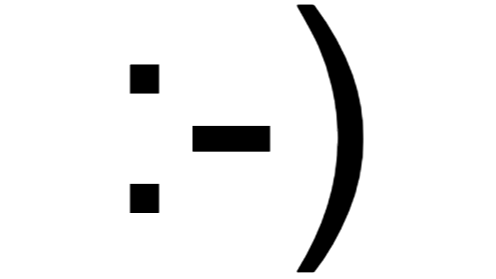The first e-mote turned 40 this week
Don't you feel old? :-)

This week the emote that started it all turns 40. Scott Fahlman, a professor at Carnegie Mellon, explains how the emoticon came to be on September 19, 1982. Unsurprisingly, it was because people were getting into fights online.
According to his post on the university website, in the early '80s, the Carnegie Mellon Computer Science community was really into bulletin boards—what would be referred to these days as internet forums—to talk to each other about a wide range of topics. Falman noticed that some sarcastic or humorous posts would be taken seriously and lead to lengthy angry exchanges, which would deviate from the original topic.
Of course, nothing like that ever happens on the internet of today. Never. =/
This led the professor and others to figure out ways "to explicitly mark posts that were not to be taken seriously." Anyone who has ever gotten into an argument online with someone who fails to pick up on a joke could probably sympathize.
As Fahlman puts it, "After all when using text-based online communication, we lack the body language or tone-of-voice cues that convey this information when we talk in person or on the phone."
So this is what he came up with:
I propose that the following character sequence for joke makers:
:-)
Keep up to date with the most important stories and the best deals, as picked by the PC Gamer team.
Read it sideways. Actually, it is probably more economical to mark things that are NOT jokes, given the current trends. For this, use
:-(
happy birthday :-) pic.twitter.com/ArUfGZqjinSeptember 19, 2022
From then on, users on the bulletin boards started posting their own text-based variations of the smiley face, like a smiley face with glasses or a Santa Clause. Since this was the '80s, this was all these ASCII-based computers could handle. This would then evolve into the smiley faces emojis we use daily when we talk to each other over the years. As it turns out, Falman isn't the biggest fan of current-day emojis, calling them "ugly" in an interview with HuffPost.
Some would argue that using emoticons has harmed how we communicate with each other despite being around forever. To some extent, Falhman agrees but points out that "not all people who post on boards have the literary skill of Shakespeare or Twain, and even those luminaries had bad days" and that "we’re talking here about casual writing on the Internet, not great works printed in one-way media that relatively inaccessible to the general public."
So the next time you use =p at the end of a sarcastic text. You now know who to thank.
Best CPU for gaming: Top chips from Intel and AMD
Best gaming motherboard: The right boards
Best graphics card: Your perfect pixel-pusher awaits Best SSD for gaming: Get into the game first

Jorge is a hardware writer from the enchanted lands of New Jersey. When he's not filling the office with the smell of Pop-Tarts, he's reviewing all sorts of gaming hardware, from laptops with the latest mobile GPUs to gaming chairs with built-in back massagers. He's been covering games and tech for over ten years and has written for Dualshockers, WCCFtech, Tom's Guide, and a bunch of other places on the world wide web.


